
By Martin Garwood
Martin has been interested in birds from an early age and has traveled extensively in pursuit of different species. He has a particular passion for Swifts. He recently set up a charity, High Weald Swifts, to promote conservation in the UK of this now “red-listed” species. Martin spent his working life in primary education, was formerly a trustee of Kent Wildlife Trust, and as a keen wildlife photographer, completed a Masters’s degree in photography in 2015. He lives in Southeast England, writes articles about wildlife for local journals, exhibits his photos, and gives talks. He is rarely seen without a camera and binoculars around his neck.
In his film “The Birds,” Alfred Hitchcock turned flocks of crows and gulls into terrorising mobs filled with a rapacious blood lust and reaping havoc on an otherwise quiet seaside hamlet. As a birder, I find it hard to believe that there are people who really do not like birds at all and that a few find them a source of Hitchcockian fear, even terror. But some do. I have a near neighbour who belongs to this group, and just a few House Sparrows settling noisily in the trees in the garden is enough to send her running indoors. For most of us, however, seeing a big flock of birds crossing the sky is a great treat. Here in the UK going to witness a murmuration of Starlings as they settle to roost in their thousands at key sites around the country has become a national pastime; it is an annual ritual for me too. Spectacular numbers of birds do occur for sure, there are the winter arrivals of geese that occur in Scotland and wintering waders along the coast, but witnessing large flocks is an infrequent experience these days in our nature-depleted country. My recent late winter trip to Georgia featured some fabulous species and gave me several new ones to add to my life list, but one of my enduring memories will be witnessing some spectacular flocking behaviours.
Our original travel plans for early March needed to be changed due to heavy snowfalls, so the first part of our trip took us almost due south, rather than north into the mountains, from Tbilisi into the Chachuna Managed Reserve. Here the rolling fields and steppe were host to huge numbers of Bramblings, foraging for seeds in their thousands beneath the light covering of snow on the fields. Normally a bird seen in small numbers, if at all, in the South of England where I live, here were huge flocks almost constantly on the move in great waves in fields either side of our vehicle as we drove through the reserve, flushing them in whirling clusters from the taller vegetation either side of our track. It was an extraordinary experience, almost as if the whole of Western Europe’s Bramblings were wintering here, perhaps they were. With the smaller numbers of larks and buntings also present, it was no wonder that Hen Harriers were a regular and much-enjoyed sight.
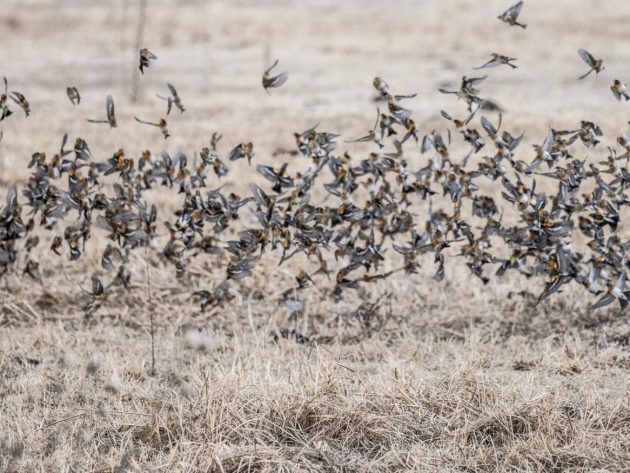
A swirl of Bramblings flushed from beside our vehicle

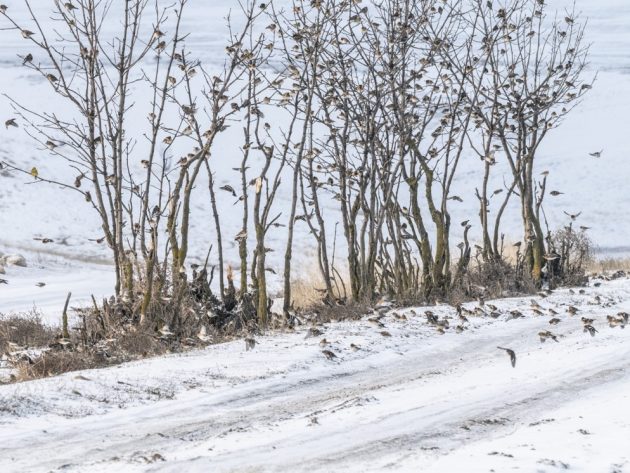
Bramblings and yet more Bramblings
The next part of our trip took us north and then east from Dedoplistskaro towards the very edge of this small country and to the Vashlovani Strict Reserve, designated a UNESCO biosphere reserve just a few years ago. This vast protected area of deep ravines, desert, and steppe on the border with Azerbaijan is the wintering ground for Little Bustard, our main quarry. Not having seen one before (this was a lifer), the sight of hundreds flying in huge flocks, flashing the large white patches on their wings, was quite astonishing. If there is such a thing as a murmuration of bustards this was surely what we were witnessing. Once landed, the birds were hard to pick out, matching the steppe vegetation closely, but once airborne, the mobile groups were wonderful to see as they sought fresh areas to settle on and forage in, and as one flock landed, another would take off. Our guide estimated that there were at least 6000 birds wintering in this rarely visited, unique, and stunning landscape. During our stay, there was hardly a time when a flock was not gracing the skyline.
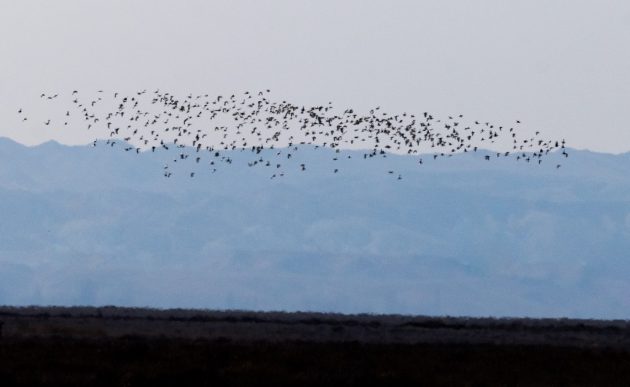
One of several large, mobile flocks of Little Bustards
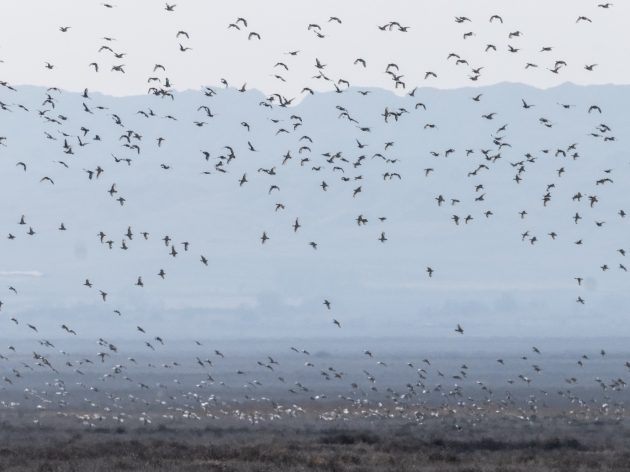
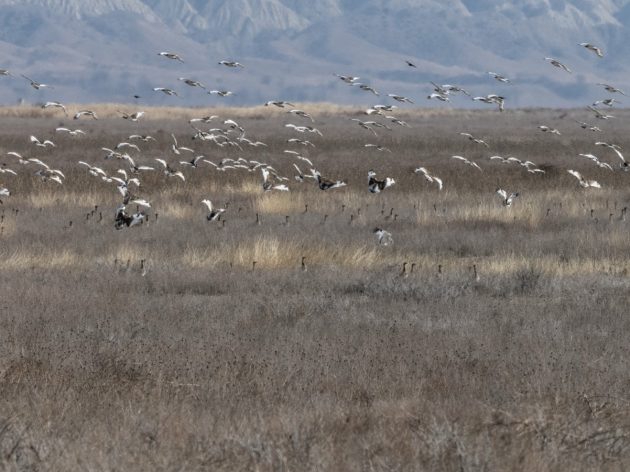
A group of Little Bustards landing and almost disappearing into the steppe vegetation
Once the road north from the capital to Stepantsminda was cleared of snow and open to traffic again, we were able to drive up into the Caucasus mountains and shift our focus from birds of the steppe to those of the high peaks. There were memorable birds to be seen here in the gorges and mountaintops, and we managed to see most of our target species with the exception of the Great Rosefinch, which had uncharacteristically spurned its normal winter feeding sites in the berry-rich valleys. Alpine Choughs were a constant presence at these heights. In winter, they form large chattering flocks swirling together over the peaks and swarming down over the craggy slopes in their hundreds, descending en masse to feed on the sun-warmed Sea Buckthorn bushes along the valley floor. Taking flight at the slightest disturbance, off they would go back up to the peaks before swirling down again to feed. Choughs are really fine birds with glossy black plumage and bright yellow beaks. Seeing just one or two in their mountain habitat is a real privilege, but it was the sheer number of birds in flight together that made the experience even more remarkable and the stuff of lasting birding memories. Big flocks have a magic all of their own.
As a child and avid consumer of books about natural history, I was both fascinated and horrified reading about the extinction of the American Passenger Pigeon, whose huge flocks were reputed to blot out the sun as they passed overhead. Looking back now this was perhaps one of several influences on my developing a concern for birds and their conservation. Perhaps this also programmed me to be a little reassured about our natural world when I get to see a really good flock of birds.
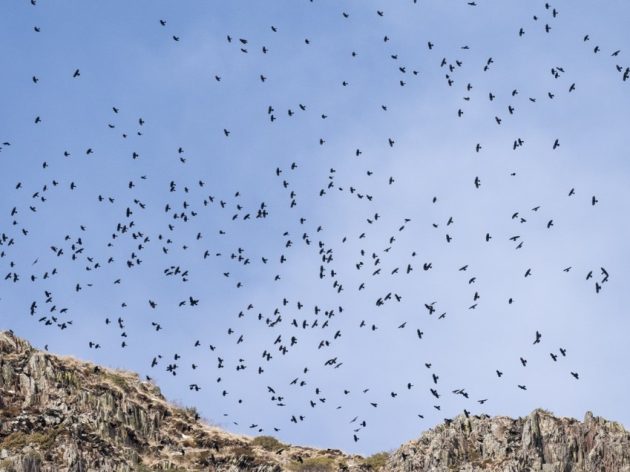

A flock of Alpine Choughs raiding the berry bushes along the valley floor near Stepantsminda

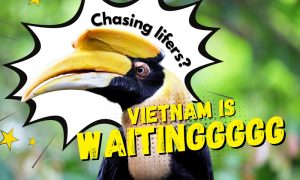
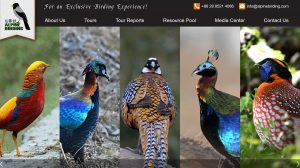
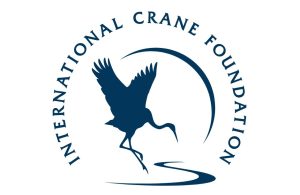
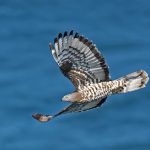

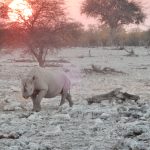
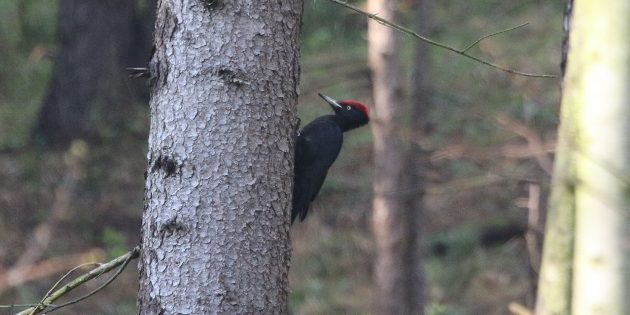
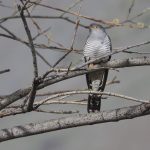

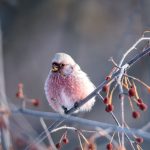
Really cool photos. I am intrigued by such a flock of Little Bustards. Inspiring too!